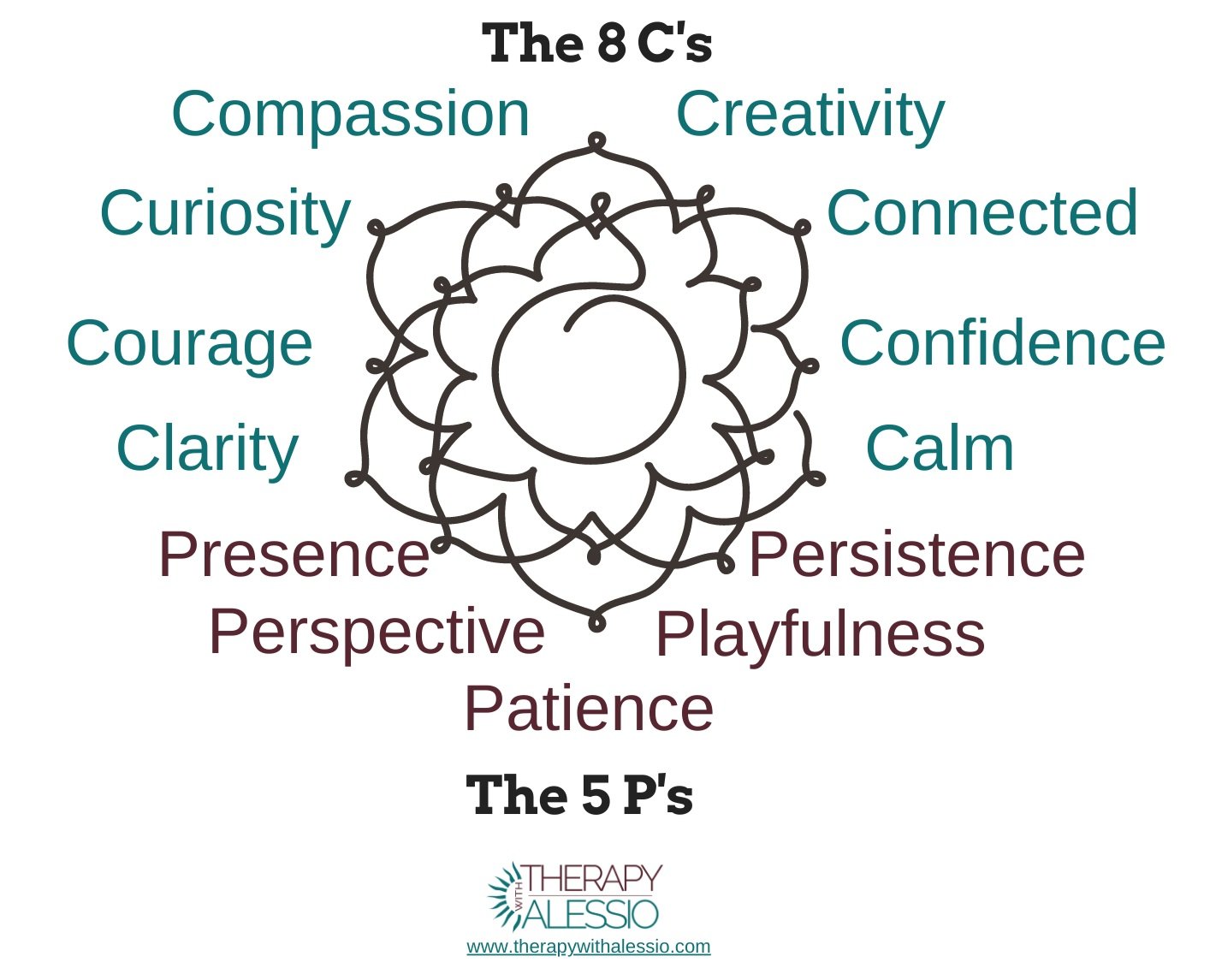In this article, I am going to talk about the qualities of Self. At the bottom of the page, you will find
A link to download a free pdf file with all the 8 C’s and 5P’s.
A link to a meditation I have created to help people get in touch with the qualities of Self.
Richard Schwartz, the founder of IFS Therapy, stumbled across something that he has named “Self” while working with clients using parts.
The Self in IFS refers to a concept that is new to psychotherapy, and it is, therefore, important to approach it with an attitude of “not knowing” rather than trying to match it to some pre-existing ideas we might refer to as “self”.
The concept of Self in IFS is a way to describe a state in which all people seem to fall into in certain situations. Operationally, during an IFS session, this state can be reached by identifying and unblending from all of the parts that are active in a specific moment.
The 8 C’s and 5 P’s of Self
Richard Schwartz found that, no matter what parts came up in a session with a client, when they all agreed to step back, clients would start to show certain qualities. For starters, with sufficient unblending, clients felt less fear and started to feel calmer (1C). This usually had an embodied element of "feeling more space”.
Also, the attitude shown towards parts started to change remarkably. Parts that, at first, were attacked (by other parts) with judgement, started to be addressed with more patience (1P) and confidence (2C).
From this state, clients were able to relate to parts in a very different way, showing an ability to connect (3C) that was not available before. First of all, there was more curiosity (4C) towards parts (rather than fear, judgement, or desire to get rid of them) and parts started to spontaneously open up as they felt the presence (2P) of the client’s Self.
Once parts started to open up, the client could start to appreciate why parts were doing, behaving and feeling in certain ways. The increased understanding of the reasons behind a part’s behaviour led to more clarity (5C), and, once parts started to share the difficult situations that caused (and perhaps still cause) their responses, a sense of compassion (6C) developed.
From a place of compassion, the Self spontaneously showed the courage (7C) to help the parts in the way they wanted to be helped. Thanks to the Self’s creativity (8C), new ways could be found to give the parts exactly what they needed to unburden, change, heal and assume new roles in the system. Even when the process was not smooth, Self showed persistence (3P) and perspective (4P) by staying with the parts for a long as they needed and at the pace that was most beneficial.
Often, once parts healed, the Self showed features of playfulness (5P) when engaging with parts.
To recap, here is a list of the 8 C’s
Curiosity
Compassion
Clarity
Connectedness
Creativity
Courage
Confidence
Calm
And of the 5 P’s
Patience
Presence
Persistence
Perspective
Playfullness
Going beyond the 8 C’s and 5 P’s
The above is just an example of how the qualities of Self known as 8 C’s and 5 P’s can show up during a session (and in everyday life) and it is important to clarify that
The Self can have more qualities than those listed here and in IFS textbooks
Self is a state from which all those qualities are available and can be expressed, and parts can also show some of these qualities (they are not exclusive to Self)
Not all qualities of Self are needed to heal parts
While the list of qualities can help orientate IFS practitioners and clients at the beginning of their IFS journey, a level of intuition and attunement is needed by the therapist to appreciate the quality of Self energy available at any point during therapy. Therapeutic changes and healing happen when enough Self energy is felt by parts. Self energy enables protectors to open up and share what is keeping them in their current roles, and also supports parts releasing burdens when they are ready.
Please notice that Self energy is the healing quality of IFS, and this means that parts with enough Self energy can help other parts heal and change. The caveat is that the extent and depth of healing that a part with Self energy can reach is less than what can be achieved when it is Self directly making contact to a part.
How do we know if we are dealing with Self or with a part with plenty of Self energy?
In a nutshell, we don’t know and the only way to find out is to ask the client. If the therapist or client suspects that a state might be a part and not Self, they can ask directly. Parts with high levels of Self energy should have enough clarity to answer the question and reveal whether they are Self or not.
An indirect way of checking whether it is a part or Self talking to, let’s say, another part, is to notice how the part is responding. When a part responds in a way that is not cooperative, it usually means that Self is not the one contacting this part.
The importance of Self in IFS and life
The idea of Self, which took me personally a while to embrace because I have skeptical parts that needed to convinced by trainers and by my supervisor, is a game changer because if affirms that
Who we truly are, is a being full of love, clarity, competence and confidence
Take a moment to take this in for a while. When do we ever look at ourselves and recognise these qualities? IFS tells us that these qualities lie within us and do not need to be cultivated or practiced.
All the qualities of Self are there, in every human being, and they emerge spontaneously when obstacles are removed
Take another moment to reflect on the statement above. When our parts allow us to be in Self, all these qualities become available not just to us, but also to others. From this lens, even the people who bother us the most can seen as having a Self with qualities that can become available under the right circumstances.
Battles, fights and violence are, therefore, the result of people whose parts have taken over the body and do not allow Self energy to lead the way.
Concluding Thoughts
The idea of Self challenges our thinking about who we really are. Even after years of reflection and practice of IFS as a therapist and as a client, part of me still finds it difficult to see so many good qualities in me and others… and to believe that these qualities can be accessed when parts allow Self to take the lead means reconsidering not only my behaviours, but also my opinions of others.
There will probably never be a scientific proof that Self exists because of its elusive nature. It cannot be recorded externally and, therefore, it cannot be measured. All we know is that everybody seems to have the potential to be in that state and, when Self leads, changes and healing that were not possible before become available.
Instead of leaving you with these thoughts, I am going to leave you with a file you can download to keep in mind the 8 C’s and 5 P’s of Self. I hope you enjoy it.
Pdf download link





